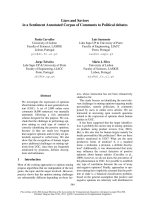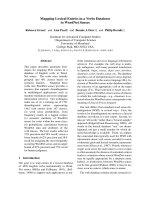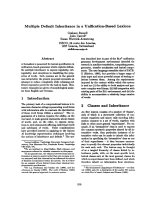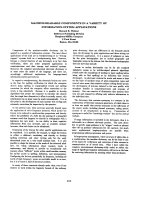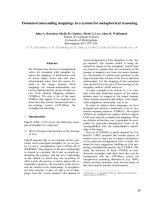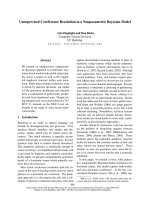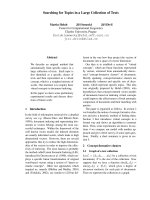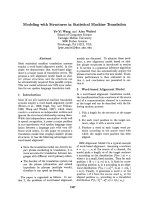Báo cáo khoa học: "Coping With Derivation in a Morphological Component" pot
Bạn đang xem bản rút gọn của tài liệu. Xem và tải ngay bản đầy đủ của tài liệu tại đây (704.95 KB, 9 trang )
Coping With Derivation in a Morphological Component *
Harald Trost
Austrian Research Institute for Artificial Intelligence
Schottengasse 3, A-1010 Wien
Austria
email:
Abstract
In this paper a morphological component
with a limited capability to automatically
interpret (and generate) derived words is
presented. The system combines an ex-
tended two-level morphology [Trost, 1991a;
Trost, 1991b] with a feature-based word
grammar building on a hierarchical lexicon.
Polymorphemic stems not explicitly stored
in the lexicon are given a compositional in-
terpretation. That way the system allows
to minimize redundancy in the lexicon be-
cause derived words that are transparent
need not to be stored explicitly. Also, words
formed ad-hoc can be recognized correctly.
The system is implemented in CommonLisp
and has been tested on examples from Ger-
man derivation.
1 Introduction
This paper is about words. Since word is a rather
fuzzy term we will first try to make clear what word
means in the context of this paper. Following [di Sci-
ullo and Williams, 1989] we discriminate two senses.
One is the morphological word which is built from
morphs according to the rules of morphology. The
other is the syntactic word which is the atomic entity
from which sentences are built according to the rules
of syntax.
*Work on this project was partially sponsored by
the Austrian Federal Ministry for Science and Research
and the "Fonds zur FSrderung der wissenschaftlichen
Forschung" grant no.P7986-PHY. I would also like
to
thank John Nerbonne, Klaus Netter and Wolfgang Heinz
for comments on earlier versions of this paper.
These two views support two different sets of infor-
mation which are to be kept separate but which are
not disjunctive. The syntactical word carries infor-
mation about category, valency and semantics, infor-
mation that is important for the interpretation of a
word in the context of the sentence. It also carries in-
formation like case, number, gender and person. The
former information is basically the same for all dif-
ferent surface forms of the syntactic word 1 the latter
is conveyed by the different surface forms produced
by the inflectional paradigm and is therefore shared
with the morphological word.
Besides this shared information the morphologi-
cal word carries information about the inflectional
paradigm, the stem, and the way it is internally
structured. In our view the lexicon should be a me-
diator between these two views of word.
Traditionally, the lexicon in natural language pro-
cessing (NLP) systems is viewed as a finite collection
of syntactic words. Words have stored with them
their syntactic and semantic information. In the
most simple case the lexicon contains an entry for
every different word form. For highly inflecting (or
agglutinating) languages this approach is not feasible
for realistic vocabulary sizes. Instead, morphological
components are used to map between the different
surface forms of a word and its canonical form stored
in the lexicon. We will call this canonical form and
the information associated with it lezeme.
There are problems with such a static view of the
lexicon. In the open word classes our vocabulary is
potentially infinite. Making use of derivation and
compounding speakers (or writers) can and do al-
ways create new words. A majority of these words
IFor some forms like the passive PPP some authors
assume different syntactic features. Nevertheless they are
derived regularly, e.g., by lexical rules.
368
are invented on the spot and may never be used
again. Skimming through real texts one will always
find such ad-hoc formed words not to be found in
any lexicon that are nevertheless readily understood
by any competent reader. A realistic NLP system
should therefore have means to cope with ad-hoc
word formation.
Efficiency considerations also support the idea of
extending morphological components to treat deriva-
tion. Because of the regularities found in derivation
a lexicon purely based on words will be highly re-
dundant and wasting space. On the other hand a
large percentage of lexicalized derived words (and
compounds) is no longer transparent syntactically
and/or semantically and has to be treated like a
monomorphemic lexeme. What we do need then is
a system that is flexible enough to allow for both a
compositional and an idiosyncratic reading of poly-
morphemic stems.
The system described in this paper is a combi-
nation of a feature-based hierarchical lexicon and
word grammar with an extended two-level morphol-
ogy. Before desribing the system in more detail we
will shortly discuss these two strands of research.
2 Inheritance Lexica
Research directed at reducing redundancy in the lexi-
con has come up with the idea of organizing the infor-
mation hierarchically making use of inheritance (see,
e.g. [Daelemans et
al.,
1992; Russell et
al.,
1992]).
Various formalisms supporting inheritance have
been proposed that can be classified into two major
approaches. One uses defaults, i.e., inherited data
may be overwritten by more specific ones. The de-
fault mechanism handles exceptions which are an in-
herent phenomenon of the lexicon. A well-known
formalism following this approach is DATR [Evans
and Gazdar, 1989].
The major advantage of defaults is the rather nat-
ural hierarchy formation it supports where classes
can be organized in a tree instead of a multiple-
inheritance hierarchy. Drawbacks are that defaults
are computationally costly and one needs an inter-
face to the sentence grammar which is usually writ-
ten in default-free feature descriptions.
Although the term default is taken from knowledge
representation one should be aware of the quite dif-
ferent usage. In knowledge representation defaults
are used to describe uncertain facts which may or
may not become explicitly known later on. 2 Excep-
tions in the lexicon are of a different nature because
they form an a priori known set. For any word it is
2An example for
the use
of defaults in knowledge rep-
resentation is an inference rule like
Birds typically can fly.
In the absence of more detailed knowledge this allows me
to conclude that Tweety which I only know to be a bird
can fly. Should I later on get the additional information
that Tweety is a penguin I must revoke that
conclusion.
known whether it is regular or an exception. 3 The
only motivation to use defaults in the lexicon is that
they allow for a more concise and natural represen-
tation.
The alternative approach organizes classes in
a multiple-inheritance hierarchy without defaults.
This means that lexical items can be described as
standard feature terms organized in a type hierarchy
(see, e.g., [Smolka, 1988; Carpenter
el al.,
1991]).
The advantages are clear. There is no need for an
interface to the grammar and computational com-
plexity is lower.
At the moment it is an open question which of the
two anppproaches is the more appropriate. In our
system we decided against introducing a new for-
malism. Most current natural language systems are
based on feature formalisms and we see no obvious
reason why the lexicon should not be feature-based
(see also [Nerbonne, 1992]).
While inheritance lexica concerned with the syn-
tactic word have mainly been used to express gen-
eralizations over classes of words the idea can also
be used for the explicit representation of deriva-
tion. In [Nerbonne, 1992] we find such a proposal.
What the proposal shares with most of the other
schemes is that not much consideration is given to
morphophonology. The problem is acknowledged by
some authors by using a function
morphologically ap-
pend
instead of pure concatenation of morphs but it
remains unclear how this function should be imple-
mented.
The approach presented here follows this line of re-
search in complementing an extended two-level mor-
phology with a hierarchical lexicon that contains as
entries not only words but also morphs. This way
morphophonology can be treated in a principled
way
while retaining the advantages of hierarchical lexica.
3 Two-Level
Morphology
For dealing with a compositional syntax and seman-
tics of derivatives one needs a component that is
capable of constructing arbitrary words from a fi-
nite set of morphs according to morphotactic rules.
Very successful in the domain of morphological anal-
ysis/generation are finite-state approaches, notably
two-level morphology [Koskenniemi, 1984]. Two-
level morphology deals with two aspects of word for-
mation:
Morphotactics: The combination rules that gov-
ern which morphs may be combined in what or-
der to produce morphologically correct words.
Morphophonology: Phonological alterations oc-
curing in the process of combination.
Morphotactics is dealt with by a so-called continua-
tion lexicon. In expressiveness that is equivalent to
a finite state automaton consuming morphs.
aWe do not consider language acquisition
here.
369
Morphophonology is treated by assuming two dis-
tinct levels, namely a lexical and a surface level. The
lexical level consists of a sequence of morphs as found
in the lexicon; the surface level is the form found
in the actual text/utterance. The mapping between
these two levels is constrained by so-called two-level
rules describing the contexts for certain phonological
alterations.
An example for a morphophonolocical alteration
in German is the insertion of e between a stem end-
ing in a t or d, and a suffix starting with s or t, e.g.,
3rd person singular of the verb
arbeiten
(to work) is
arbeitest.
In two-level morphology that means that
the lexical form
arbei~+st
has to be mapped to sur-
face
arbeitest.
The following rule will enforce just
that mapping:
(1) +:e gO {d, t} _ {s, t};
A detailed description of two-level morphology can
be found in [Sproat, 1992, chapter 3].
In its basic form two-level morphology is not well
suited for our task because all the morphosyntactic
information is encoded in the lexical form. When
connected to a syntactic/semantic component one
needs an interface to mediate between the morpho-
logical and the syntactic word. We will show in in
chapter 5 how our version of two-level-morphology is
extended to provide such an interface.
4 Derivation in German
Usually, in German derived words are morphologi-
cally regular. 4 Morphophonological alterations are
the same as for inflection only the occurrence of um-
laut is less regular. Syntax and semantics on the
other hand are very often irregular with respect to
compositional rules for derivation.
As an example we will look at the German deriva-
tional prefix
be
This prefix is both very productive
and considered to be rather regular. The prefix
be-
produces transitive verbs mostly from (intransitive)
verbs but also from other word categories. We will
restrict ourselves here to all those cases where the
new verb is formed from a verb. In the new verb
the direct object role is filled by a modifier role of
the original verb while the original meaning is ba-
sically preserved. One regularly formed example is
bearbeiten
derived from the intransitive verb
arbeiten
(to work).
(2)
[Maria]svBj arbeitet [an dem Papier]eoBj.
Mary works on the paper.
(3)
[Maria]svBJ bearbeitet [das Papier]oBj.
Skimming through [Wahrig, 1978] we find 238 en-
4Most exceptions are regularly inflecting compound
verbs derived from an irregular verb, e.g.,
handhaben (to
manipulate)
a regular verb derived from the irregular
verb
haben (to have).
tries starting with prefix
be
91 of these can be
excluded because they cannot be explained as be-
ing derived from verbs. Of the remaining 147 words
about 60 have no meaning that can be interpreted
compositionally. 5 The remaining ones do have at
least one compositional meaning.
Even with those the situation is difficult. In some
cases the derived word takes just one of the meanings
of the original word as its semantic basis, e.g.,
befol-
gen (to obey)
is derived from
folgen
in the meaning
to obey,
but not to
follow
or to
ensue:
(4)
Der Soldat folgt [dem Befehl ]~onJ.
The soldier obeys the order.
(5)
Der Soldat befolgt [den Befehl ]oBJ.
(6)
Bet Soldat folgt
[dem
017izier ]IonJ.
The soldier follows the officer.
(7)
*Der Soldat befolgt [den Offizier ]oBJ.
In other cases we have a compositional as well as
a non-compositional reading, e.g.,
besetzen
derived
from
setzen (to set)
may either mean
to set
or
to
occupy.
What is needed is a flexible system where regu-
larities can be expressed to reduce redundancy while
irregularities can still easily be handled.
5 The Morphological Component
X2MORF
X2MORF [Trost, 1991a; Trost, 1991b] that forms the
basis of our system is a morphological component
based on two-level morphology. X2MORF extends
the standard model in two way which are crucial for
our task. A feature-based word grammer replaces the
continuation class approach thus providing a natural
interface to the syntax/semantics component. Two-
level rules are provided with a morphological filter
restricting their application to certain morphological
classes.
5.1 Feature-Based Grammar and Lexicon
In X2MORF morphotactics are described by a
feature-based grammar. As a result, the represen-
tation of a word form is a feature description. The
word grammar employs a functor argument structure
with binary branching.
Let us look at a specific example. The (simplified)
entry for the noun stem
Hand
(hand) is given in fig.1.
To form a legal word that stem must combine with
an inflectional ending. Fig.2 shows the (simplified)
entry for the plural ending. Note that plural for-
mation also involves umlaut, i.e., the correct surface
5About half of them are actually derived from
words
from other classes like
belehlen (to order)
which is clearly
derived from the noun
Belehl (order)
and not the verb
fehlen (to miss).
370
r
[CAT:
N
]
MORPH: /PARAD:
e-plura
q
[.UMLAUT:
binary J
PHON:
hand
STEM:
(han~
Figure 1: Lexical entry for
Hand
(preliminary)
form is
ttSnde.
As we will see later on this is what
the feature
UMLAUT
is needed for.
CAT: N ]
~IORPH: L:c UM:
pl
ASE: {
nora yen acc }
PHON: +e
STEM: [~]
MORPH: IPARAD:
ARG: L UMLAUT:
e~plura
STEM: [~]
Figure 2: Lexical entry for suffix e (preliminary)
Combining the above two lexical entries in the
appropriate way leads to the feature structure de-
scribed in fig.3.
MORPH:
PHON:
STEM:
ARG:
!AT: N ]
UM: pi
ASE: { nor. ge.
ace }
+e
[~ hand~
CAT:
~IORPH: []FARAD:
LUML AUT:
PHON:
hand
.STEM: [~]
~
plura
Figure 3: Resulting feature structure for
H~nde
5.2 Extending Two-level Rules with
Morphological Contexts
X2MORF employs an extended version of two-level
rules. Besides the standard phonological context
they also have a morphological context in form of
a feature structure. This morphological context is
unified with the feature structure of the morph to
which the character pair belongs. This morphologi-
cal context serves two purposes. One is to restrict the
application of morphophonological rules to suitable
morphological contexts. The other is to enable the
transmission
of
information
from
the phonological to
the morphological level.
We can now show how umlaut is treated in
X2MORF. A two-level rule constrains the mapping
of A to ~ to the appropriate contexts, namely where
the inflection suffÉx requires umlaut:
(8) A:~
¢~_
;
[MORPH:
[HEAD:
[UMLAUT:
+] ]]
The occurrence of the umlaut ~ in the surface form
is now coupled to the feature UMLAUT taking the
value +. As we can see in fig.3 the plural ending has
forced the feature to take that value already which
means that the morphological context of the rule is
valid.
Reinhard [Reinhard, 1991] argues that a purely
feature-based approach is not well suited for the
treatment of umlaut in derivation because of its id-
iosyncrasy. One example are different derivations
from
Hand (hand)
which takes umlaut for plural
(ll~nde)
and some derivations
(h~ndisch)
but not for
others
(handlich)
There are also words like
Tag (day)
where the plural takes no umlaut (Tage) but deriva-
tions do
(tSglich).
Reinhard maintains that a default
mechanism like DATR is more appropriate to deal
with umlaut.
We disagree since the facts can be described in
X2MORF in a fairly natural manner. Once the
equivalence classes with respect to umlaut are known
we can describe the data using a complex feature
UMLAUT 6
instead of the simple binary one. This
complex feature UMLAUT consists of a feature for
each class, which takes as value + or - and one fea-
ture
value
for the recording of actual occurrence of
umlaut:
LrMLAUT:
"VALUE:
binary]
PL-UML:
binary]
LICH-UML:
binary I
ISCH-UML:
binaryJ
The value of the feature
UMLAUT[VALUE
is set
by
the morphological filter of the two-level rule trigger-
ing umlaut, i.e., if an umlaut is found it is set to +
otherwise to The entries of those affixes requiring
umlaut set the value of their equivalence class to +.
Therefore the relevant parts of the entries for
-iich
and
-isch
look like [UMLAUT: [UOH-U~,: +]] and
[UMLAUT: [ISCH-UML: + ]] because both these end-
ings normally require umlaut.
As we have seen above the noun
Hand
comes with
umlaut in the plural
(llSnde)
and the derived adjec-
tive
hSndisch (manually)but
(irregularly) without
umlaut in the adjective
handlich (handy).
In fig.4
we show the relevant part of the entry for
Hand
that
produces the correct results. The regular cases are
6In our simplified example we assume just 3 classes
(for plural, derivation with -lich and -isch). In reality
the
number of classes is larger but still fairly small.
371
single.stem
CAT: i
,VlORPH:
UMLAUT:
PHON:
hAnd
STEM:
(ha.~
SYNSEM:
synsem
I
VALUE: [~
PL-UML: V~]
ISCH-UML:
[~]l
LICH-UML:- J
PL-UML: [~
ISCH-UML:
[]
blCH-UML: +
Figure 4: Lexical entry for
Hand
(final version)
taken care of by the first disjunct while the excep-
tions are captured by the second.
The first disjunct in this feature structure takes
care of all cases but the derivation with
.lich.
The
entries for plural (see fig.5) and
-isch
come with the
value + forcing the VALUE feature also to have a +
value. The entry for
-lich
also comes with a + value
and therefore fails to unify with the first disjunct.
Suffixes that do not trigger umlaut come with the
VALUE feature set to
The second disjunct captures the exception for the
-lich
derivation of
Hand.
Because of requiring a -
value it fails to unify with the entries for plural and
-isch.
The + value for
-lich
succeeds forcing at the
same time the VALUE feature to be
rCAT: N
MORPH: [lCUM:
pl
ASE:
{
PHON: +e
STEM: [~]
SYNSEM: [~]
MORPH:
ARG:
nor. gen aec }]
CAT: N ] ]
PARAD :
e-plural
UMLAUT: [PL-UMLAUT: +]
STEM: []
.SYNSEM: ~]
Figure 5: Lexical entry for suffix e (final version)
This mechanism allows us to describe the umlaut
phenomenon in a very general way while at the same
time being able to deal with exceptions to the rule
in a simple and straightforward manner.
5.3 Using X2MORF directly for derivation
Regarding morphotactics and morphophonology
there is basically no difference between inflection and
derivation. So one could use X2MORF as it is to
cope with derivation. Derivation particles are word-
forming heads [di Sciullo and Williams, 1989] that
have to be complemented with the appropriate (sim-
ple or complex) stems. Words that cannot be inter-
preted compositionally anymore have to be regarded
as monomorphemic and must be stored in the morph
lexicon.
Such an approach is possible but it poses some
problems:
* The morphological structure of words is no more
available to succeeding processing stages. For
some phenomena just this structural informa-
tion is necessary though. Take as an example
the partial deletion of words in phrases with con-
junction
(gin- und Vcrkan]).
• The compositional reading of a derived word
cannot be suppressed r, even worse, it is indis-
tinguishable from the correct reading (remem-
ber the
befehlen
example).
• Partial regularities cannot be used anymore to
reduce redundancy.
Therefore we have chosen instead to augment
X2MORF with a lexeme lexicon and an explicit in-
terface between morphological and syntactic word.
6
System Architecture
Logically, the system uses two different lexica.
A morph lexicon
contains MI the morphs, i.e.,
monomorphemic stems, inflectional and derivational
affixes. This lexicon is used by X2MORF. A
iezeme
lexicon
contains the lexemes, i.e. stem morphs and
derivational endings (because of their word-forming
capacity). The lexical entries contain the lexeme-
specific syntactic and semantic information under
the feature SYNSEM.
These two lexica can be merged into a single type
hierarchy (see fig.6) where the morph lexicon en-
tries are of type
morph
and lexeme lexicon entries
of type
lezeme. Single-stems
and
deriv-morphs
share
the properties of both lexica.
ZOne could argue that the idea of preemption is incor-
rect anyway and that only syntactic or semantic restric-
tions block derivation. While this may be true in theory
at least for practical considerations we will need to be
able to block derivation in the lexicon.
37?
lez.entry
moth lezeme
mfle~
single-stem complex-stem
Figure 6: Part of the type lattice of the lexicon
Since we have organized our lexica in a type hier-
archy we have already succeeded in establishing an
inheritance hierarchy. We can now impose any of the
structures proposed in the literature (e.g., [Krieger
and Nerbonne, 1991; Russell
et al.,
1992]) for hierar-
chical lexica on it, as long as they observe the same
functor argument structure of words crucial to our
morphotactics.
Why are we now in a better situation than
by using X2MORF directly? Because complex
stems are no morphs and therefore inaccessible to
X2MORF. They are only used in a second process-
ing stage where complex words can be given a non-
compositional reading. To make this possible the as-
signing of compositional readings must also be post-
poned to this second stage. This is attained by giving
derivation morphs in the lexicon no feature
SYNSEM
but stating the information under
FUNCTOR]SYNSEM
instead.
In the first stage X2MORF processes the morpho-
tactic information including the word-form-specific
morphosyntactic information making use of the
morph lexicon. The result is a feature-description
containing the morphotactic structure and the mor-
phosyntactic information of the processed word form.
What has also been constructed is a value for the
STEM
feature that is used as an index to the lexeme
lexicon in the second processing stage, s
In the second stage we have to discriminate be-
tween the following cases:
• The stem is found in the lexeme lexicon. In case
of a monomorphemic stem processing is com-
pleted because the relevant syntactic/semantic
information has already been constructed dur-
ing the first stage. In case of a polymorphemic
stem the retrieved lexical entry is unified with
the result of the first stage, delivering the lexi-
calized interpretation.
SInflectional endings do not contribute to the stem.
Also, allomorphs like irregular verb forms share a com-
mon stem.
The stem is
not
found in the lexeme lexicon. In
that case a compositional interpretation is re-
quired. This is achieved by unifying the result
of stage one with the feature structure shown
in fig.7 This activates the SYNSEM information
of the functor-which must be either an inflec-
tion or a derivation morph. In case of an in-
flection morph nothing really happens. But for
derivation morphs the syntactic/semantic infor-
mation which has already been constructed is
bound to the feature SYNSEM. Then the process
must recursively be applied to the argument of
the structure. Since all monomorphemic stems
and all derivational affixes are stored in the lex-
eme lexicon this search is bound to terminate.
"FUNCTOR:
[SYNSEIVI: [~]
complex.stem
SYNSEM: ['~
Figure 7: Default entry in the lexeme lexicon
How does this procedure account for the flexibility
demanded in section 4. By keeping the compositional
synyactic/semantic interpretation local to the rune-
tot during morphological interpretation the decision
is postponed to the second stage. In case there is
no explicit entry found this compositional interpre-
tation is just made available.
In case of an explicit entry in the lexeme lexicon
there is a number of different possibilities, among
them:
• There are just lexicalized interpretations.
• There is a compositional as well as a lexiealized
interpretation.
• The compositional interpretation is restricted to
a subset of the possible semantics of the root.
The entries in the lexeme lexicon can easily be
tailor-made to fit any of these possibilities.
373
deriv.morpA
"PHON:
MORP
H:
STEM:
FUNCTOR:
ARQ:
be+
[:i:] [HE,D: [O,T" q]
(aPPend ~7 [~])
?MORPH: [HEAD: [-~
STEM:
[~3(be)
SYNSEM: CAT: [SUBCAT:
(appendNP[OBJ][~_], [~])
tOO.T:
,o.tod
"H .:STEM: q ]]
tOONT:N
Figure 8: Lexical entry for the derivational prefix be-
7 A Detailed Example
We will now illustrate the workings of the system
using a few examples from section 4. The first ex-
ample describes the purely compositional case. The
verb
betreten (to enter)
can be regularly derived from
treten (to enter)
and the suffix
be
The sentences
(9)
Die Frau tritt [in das Zimmer]POBd.
The woman enters the room.
(10)
Die Frau betritt [das Zimmer]oBJ.
are semantically equivalent. The prepositional ob-
ject of the intransitive verb
treten
is transformed into
a direct object making
betreten
a transitive verb. A
number of verbs derived by using the particle
be-
follows this general pattern. Figure 8 shows-a sim-
plified version of-the lexical entry for
be
The SYNSEM feature of the functor contains the
modified syntactic/semantic description. Note that
the lexical entry itself contains no SYNSEM feature.
When analyzing a surface form of the word
betreten
this functor is combined with the feature structure
for
treten
(shown in fig.9) as argument.
At that stage the
FUNCTORISYNSEM
feature of
be-
is
unified with the
SYNSEM
feature of
treten.
But
there is still no value set for the
SYNSEM
feature.
This is intended because it allows to disregard the
composition in favour of a direct interpretation of the
derived word. In our example we will find no entry
for the stem
betreten
though. We therefore have to
take the default approach which means unifying the
result with the structure shown in fig.7.
Up to now our example was overly simplified be-
cause it did not take into account that
treten has
a second reading, namely
to kick.
The final lexical
entry for treten is shown in fig.10.
But this second reading of
treten
cannot be used
for deriving a second meaning of
betreten:
(11)
Die Frau 1tilt [den Huna~oss.
The woman kicks the dog.
(12)
*Die Frau betritt [den Hnna~oB.~.
We therefore need to block the second compositional
interpretation. This is achieved by an explicit entry
for
betreten
in the lexeme lexicon which is shown in
fig.ll.
single-ster~
Figure 9:
'PHON:
trEt
[O T" V]]
STEM:
tret)
' [HEAD:
verb
CAT:
[sunoAT:
(NP[SVBJ] ,
SYNSEM: [REL:
fret '
CONT:
IAGENT: [~persor
LTO:
~to-loc
Lexical entry for verb
treten
(preliminary version)
374
single.stem
"PHON:
trEt
MoRPR- [READ: [OAT: q]
STEM:
( tret)
"HEAD:
verb ]
CAT:
SUBCAT:
(NPtSUBJ]F], PI~)
"REL:
tret '
AGENT:
[ l~rsor
I [CONT:
.TO:
~]to-loc
SYNSEM: I ]HEAD: verb ]]
CAT:
[SUBCAT:
(NP[SUB.I][~],
NP[OBJ]~])
[REL: t t" ]
[THEME:
~]animateJ
Figure 10: Lexical entry for
treten
(final version)
FUNCTOR:
STEM:
• . ISYNSEM:
complez-s~eml.
[S SEM" [] ]
(be tret)
IT][°ONT: [REL" t~t']]
Figure 11: Entry for
betreten
in the lexeme lexicon
We now get the desired results. While both read-
ings of
treten
produce a syntactic/semantic interpre-
tation in the first stage the incorrect one is filtered
out by applying the lexeme lexicon entry for
betreten
in the second stage.
8 Conclusion
In this paper we have presented a morphological ana-
lyzer/generator that combines an extended two-level
morphology with a feature-based word grammar that
deals with inflection as well as derivation. The gram-
mar works on a lexicon containing both morphs and
lexemes.
The system combines the main advantage of two-
level morphology, namely the adequate treatment of
morphophonology with the advantages of feature-
based inheritance lexica. The system is able to auto-
matically deduce a compositional interpretation for
derived words not explicitly contained in the sys-
tem's lexicon. Lexicalized compounds may be en-
tered explicitly while retaining the information about
their morphological structure. That way one can im-
plement blocking (suppressing compositional read-
ings) but is not forced to do so.
References
[Backofen
et al.,
1991] Rolf Backofen, Harald Trost,
and Hans Uszkoreit. Linking Typed Fea-
ture Formalisms and Terminological Knowl-
edge Representation Languages in Natural Lan-
guage Front-Ends. In
W. Bauer, editor. Pro-
ceedings GI Kongress Wissensbasierte Systeme
199I,
Springer, Berlin, 1991.
[Carpenter
et al.,
1991] Bob Carpenter, Carl Pol-
lard, and Alex Franz. The Specification and
Implementation of Constraint-Based Unifica-
tion Grammars. In
Proceedings of the Sec-
ond International Workshop on Parsing Tech-
nology,pages
143-153, Cancun, Mexico, 1991.
[Daelemans
et al.,
1992] Walter Daelemans, Koen-
raad De Smetd, and Gerald Gazdar. Inheritance
in Natural Language Processing.
Computational
Linguistics
18(2):205-218, June 1992.
[Evans and Gazdar, 1989] Roger Evans and Gerald
Gazdar. Inference in DATR. In
Proceedings of
the
~th Conference of the European Chapter of
the ACL,
pages 66-71, Manchester, April 1989.
Association for Computational Linguistics.
[Heinz and Matiasek, 1993] Wolfgang Heinz and Jo-
hannes Matiasek. Argument Structure and Case
Assignment in German. In
J. Nerbonne, K. Net-
ter, and C. Pollard, editors. HPSG for German,
CSLI Publications, Stanford, California, (to ap-
pear), 1993.
[Koskenniemi, 1984] Kimmo Koskenniemi. A Gen-
eral Computational Model for Word-Form
Recognition and Production. In
Proceed-
ings of the lOth International Conference
on
Computational Linguistics,
Stanford, Califor-
nia, 1984. International Committee on Com-
putational Linguistics.
[Krieger and Nerbonne, 1991] Hans-Ulrich Krieger
and John Nerbonne. Feature-Based Inheritance
Networks for Computational Lexicons. DFKI
375
Research Report RR-91-31, German Research
Center for Artificial Intelligence, Saarbriicken,
1991.
[Nerbonne, 1992] John Nerbonne. Feature-Based
Lexicons: An Example and a Comparison to
DATR. DFKI Research Report RR-92-04, Ger-
man Research Center for Artificial Intelligence,
Saarbriicken, 1992.
[Reinhard, 1991] Sabine Rein-
hard. Ad~quatheitsprobleme automatenbasierter
Morphologiemodelle am Beispiel der deulschen
Umlautung. Magisterarbeit, Universit~it Trier,
Germany, 1990.
[Russell et al., 1992] Graham Russell, Afzal Ballim,
John Carroll, and Susan Warwick-Armstrong. A
Practical Approach to Multiple Default Inheri-
tance for Unification-Based Lexicons. Compu-
tational Linguistics, 18(3):311-338, September
1992.
[di Sciullo and Williams, 1989] Anna-Maria di Sci-
ullo and Edwin Williams. On the Definition of
Word. MIT Press, Cambridge, Massachusetts,
1987.
[Sproat, 1992] Richard Sproat. Morphology and
Computation. MIT Press, Cambridge, Mas-
sachusetts, 1992.
[Smolka, 1988] Gerd Smolka. A Feature Logic with
Subsorts. LILOG-Report 33, IBM-Germany,
Stuttgart, 1988.
[Trost, 1991a] Harald Trost. Recognition and Gen-
eration of Word Forms for Natural Language
Understanding Systems: Integrating Two-Level
Morphology and Feature Unification. Applied
Artificial Intelligence, 5(4):411-458, 1991.
[Trost, 1991b] Harald Trost. X2MORF: A Morpho-
logical Component Based on Two-Level Mor-
phology. In Proceedings of the 12th Inter-
national Joint Conference on Artificial Intel-
ligence, pages 1024-1030, Sydney, Australia,
1991. International Joint Committee on Arti-
ficial Intelligence.
[Wahrig, 1978] Gerhard Wahrig, editor, dry
W6rterbuch der deutschen Sprache. Deutscher
Taschenbuch Verlag, Munich, Germany, 1978.
376
